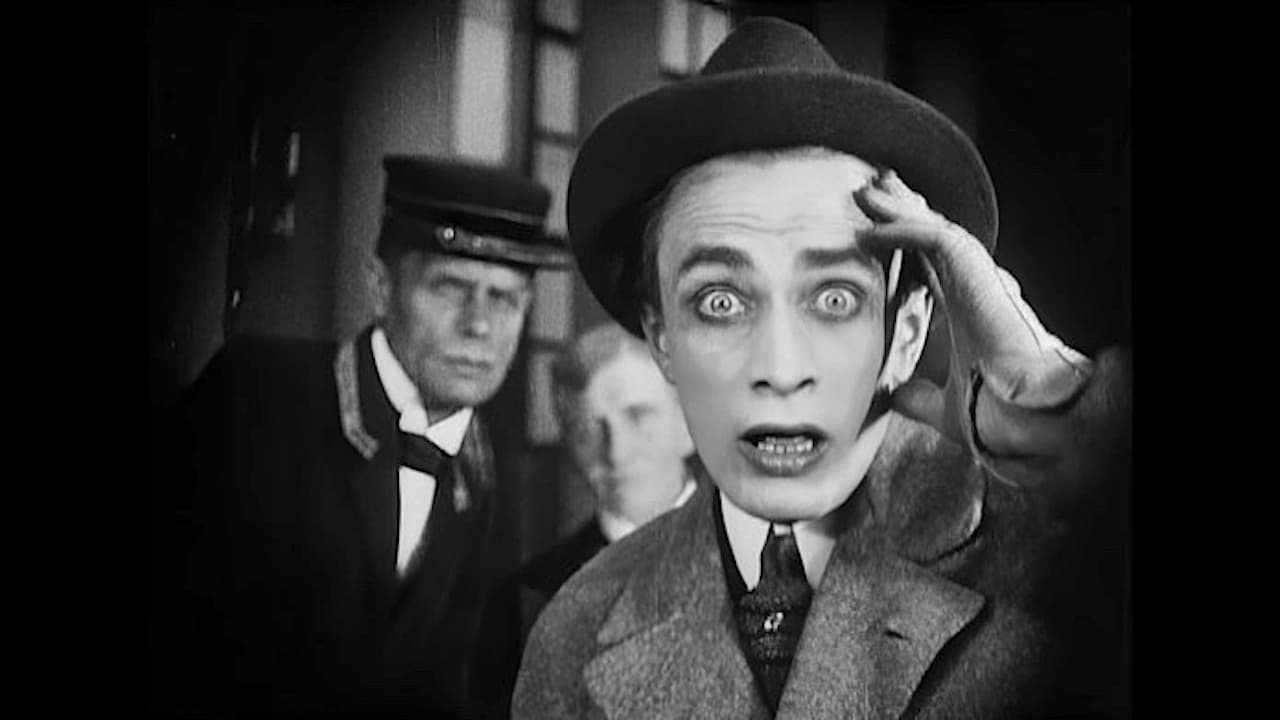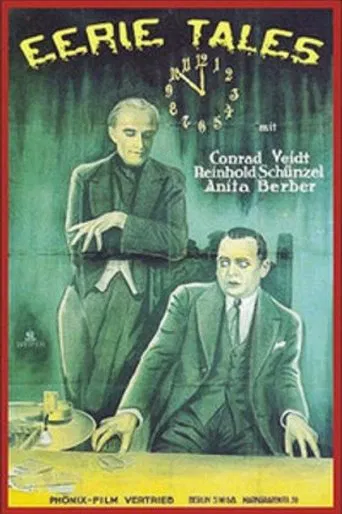Redwarmin
This movie is the proof that the world is becoming a sick and dumb place
Freaktana
A Major Disappointment
Borgarkeri
A bit overrated, but still an amazing film
Horst in Translation (filmreviews@web.de)
"Unheimliche Geschichten" (and I could list a dozen alternate titles here, in English and German) is a German black-and-white silent film that run slightly over 2 hours in the original, but slightly under 100 minutes in the DVD version. Actually, this is not really a movie, but rather a collection of 5 short stories told to each other by creepy horror creatures. Anita Berber, Conrad Veidt and Reinhold Schünzel play all the major characters in here and, in my opinion, the only one who makes it somewhat worth watching is Veidt. He was still pretty young here just like the other two, so this was a bit of a film by the new generation of actors. But this Richard Oswald movie was never a rewarding watch. It was not emotional, not engaging, not dramatically relevant and certainly not scary. There are many better German silent horrors from around that time. I do not recommend watching this one. Thumbs down, it dragged on several occasions. And the intertitles as poems were simply bad. They should have been normal text and a lot more frequent.
jshoaf
An aspect of this film that amused me was that four out of the five stories involve romantic triangles of one sort or another. A man picks up a woman who cries on his shoulder, and pretty soon he's kissing her in her bedroom, though he is pushed out because she has a headache (oops, the plague). Two men decide that the girl who has left them at a club to dance with somebody else must belong to one of them, so they throw dice for her; she is surprised to find one of them lying on her couch when she comes home and not pleased that he's a corpse; when she meets the other a few years later, they seem ready to take up where they left off. A drunkard takes a stranger home to his wife and within 30 seconds the stranger is kissing the wife (Conrad Veidt gets to do all the kissing in this movie). A wise French marquis encourages his wife to snuggle up to an amorous stranger, then shows her that he himself is a much better snuggle. All this (plus another story) in a version that only lasted about 95 minutes.Because the segments are so short, each seduction takes at most a few minutes. There is no time for anyone to be sentimental or even fall in love--it's lust at first sight in every case. True, usually someone in the story dies before fornication or adultery can be committed. But there is something about the galloping pace that brings the horror--the deaths, the hauntings--right up against the sexy parts in a balder way that is usual in the early horror movies I've seen.The film is fun because each actor gets to play a wide range of characters. Reinhold Schunzel particularly gets to play a crazy sadistic brute, a sly drunken brute, a jealous but gentlemanly brute, a masterful cop, and a charming but cowardly 18th-century marquis. Anita Berber has a scene in which she (or a double? there was more costume around her head than around her legs) performs a fairly lengthy piece of modern dance--this character is a proto-flapper, but she also does quiet little 19th-c American wife and "the Strumpet" with great energy and sweetness. Veidt--well, as I said, he is the guys who get to the kissing as fast as possible in 4 of the stories, and a sadistic monster in the fifth. Who could ask for more?
hamilton65
2003 review:Richard Oswald directs a fascinating selection of tales co-starring a youthful Conrad Veidt, Reinhold Schünzel and Anita Berber.SLIGHT SPOILERSAs others have said this film has a rather casual feel to it, accentuated by the opening shots of the three actors, gathered for the camera, almost as though taking bows before the film proper. A framing sequence has the three emerge from old paintings in an antiquarian bookshop,and read the stories which the film illustrates Through most of these, Veidt and Schunzel play rivals over Berber, and the stories include Poe's "The Black Cat" and an excellent run through of Stevenson's "Suicide Club" Played for the most part in real time the latter builds a real sense of unease as the clock inexorable approaches midnight. However the best story is "Die Hand" in which Schünzel murders Berber's husband, Veidt, in order to have her to himself and is then haunted by the latter during a séance.Playing somewhat like an Amicus compendium 50 years before the event, Weird Tales may be a modest affair, but it's fast moving, atmospherically shot and occasionally stylish. The version I saw was a beautiful 2002 restoration with an evocative score and German title cards (not a problem except in the last and weakest story where the titles are in verse) Whilst it's not a great film it's fast moving and enjoyable and stands up well 84 years later. 2014 update:But it's in its central trio of performers that the film holds it's real interest – each illustrating a different aspect of how art and culture in Germany would evolve in the turbulent years to come.Most familiar is Conrad Veidt - the versatile and expressive star of German and international cinema. Here, as always, he is fascinating in what seems like a warm up for his great roles in the 20's. He became a favourite German actor, starring in dozens of films across Europe and in America. An avowed anti-Nazi, yet one who believed in the essential goodness of people, he relocated to England in 1932 but continued appearing in German productions until a notorious incident in 1934. He had just completed the remake of "William Tell and was due to return to England for "Jew Suess" a tale of a Jewish 18th Century financier who tries to ease his people's oppression through his influence at court.Knowing of this, Goebels had Veidt placed under house arrest and he was forced to write a "sick note" to the UK producer, Michael Balcon. However Balcon was suspicious and being diplomatically connected, threatened to create an international incident of this unless an approved doctor was allowed to examine Veidt. Of course Veidt was perfectly well and the Nazis were forced to release him. Veidt was subsequently vilified in the German press and from then on only worked in England, France and America and 71years after his death is remembered with particular affection by his British fans.The rather obscure Reinhold Schünzel also excels, a protean figure here, and similar in life – alternating between acting and directing throughout his career. His directorial style was influenced by his two mentors (Richard Oswald and Ernst Lubitsch,) and several of his films (Viktor und Viktoria (1933) and Amphityron (1935)) show an unmistakable light and risqué touch.Despite his Jewish background, Schunzel's success as a director was such that he was awarded the dubious distinction of Honorary Aryan and permitted to continue in Germany. But he grew frustrated by the increasing interference on his projects and left for America in 1937. He directed a few films at MGM (none with particular success) but his career stalled with the failure of " Ice Follies of 1939", a disaster of such proportion that star Joan Crawford was labelled "box-office poison".After that he returned to acting - notably as the sly Nazi doctor who suggests slowly poisoning Ingrid Bergman in Hitchcock's "Notorious". He continued in smaller parts through the early 50's before attempting to revive his directorial career in Germany.But he discovered that his association with Nazi era cinema had indelibly stained him. He was fired from his comeback film "Die Dubarry" (1951), had difficulty finding further work and died penniless in 1954. Then there's Anita Berber – resembling a 19th century version of Nina Hagan. Berber is the femme fatale at the centre of each story and in the prologue she satirises the dewy eyed heroine most leading actresses played in those days.She's an enthusiastic and energetic presence throughout the film and a good match for her co-stars.In one sequence we catch a glimpse of her dancing on stage - and it was in this guise that 19 year old Berber came to director Oswald's attention. Berber had undoubted star quality and was busy in the following years - even appearing opposite Veidt and Schunzel again. But Berber's acting was eclipsed by her real life notoriety - as artist, writer and avante-garde dancer whose performances (often nude and overtly sexual) shocked the more conservative factions. In addition her open bisexually and prolific drug taking marked her as one of the most controversial figures in 20's Berlin and she can be seen as a vampire type figure in a famous Otto Dix portrait of 1926. Berber would have perished under the Nazis - Hitler apparently described her as the "Devil's spawn". But her decadent lifestyle ensured she didn't live that long, contracting TB whilst on tour and dying at just 30 in November 1928.So watch and enjoy this little compendium, marvel at the stranger than fiction lives of those starring in this, and wonder at the dull as dirt people we think of as "stars" today.
galensaysyes
Any devotee of vintage horror films will want to see Conrad Veidt in an anthology of fantastic tales, but will be disappointed if he expects another "Waxworks" or "Destiny." This looks as if it had been tossed together rather casually, as an actors' lark, and the actors, especially Veidt, mug exuberantly. The five tales, sketchily told, are "The Black Cat," "The Suicide Club," stories of hauntings real and fake, and the old anecdote about the man whose wife disappears from an inn where everyone swears she was never there. These are read by three figures who have stepped out of paintings in an antiquarian bookshop and driven off the (exceedingly odd) owner. The three appear in all the stories, usually with the two men as rivals for the woman. The tone of the framing story and one of the tales from the books is comic, and that of the others deliberately exaggerated. The prevailing weirdness tends to neutralize the scary moments, and so does the Wagnerian music with which the version distributed by LS Video has been unwisely scored. This version doesn't look bad compared to some old films on video (one can clearly make out the actors' faces), but the condition of the print makes it impossible to tell how the film looked originally. It's no classic, but an entertaining view of a young Veidt running the gamut of extreme emoting.

